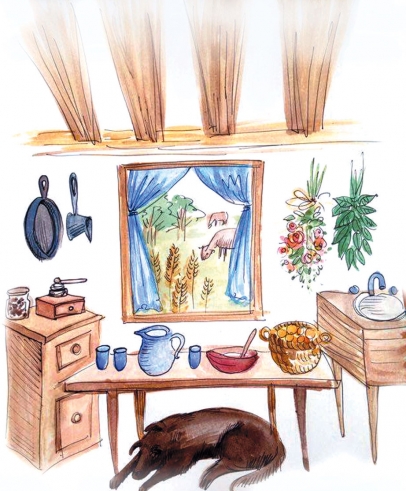A Kitchen Made with Love from the Classic Series, Little House on the Prairie
Ever After
The date was August 25, 1865. The bride wore black cashmere, her dress wrong for both the occasion and the season. The ceremony was private, just the bride, the groom and Reverend Brown. Afterward, the bride’s family toasted the newlyweds over a simple supper and cake. (A day earlier, the bride had herself whipped the meringue buttercream by hand.) Then the bride bid her family farewell. She and her groom drove off in their buggy, a soft-eyed milk cow trailing behind, a gift from her Pa to remind his daughter of home.
Readers of Laura Ingalls Wilder’s Little House series realized from the start that Laura would marry. Thanks to Farmer Boy, her memoir of her husband’s childhood years, they knew her husband almost as intimately as they knew her. And yet the moment when Almanzo drives Laura away from the Ingalls family, the story of the little girl who grew up “once upon a time...in the Big Woods” becomes a fairy tale interrupted. We follow Laura into the wilds of a new marriage and the greater wilderness of life beyond the protection of her loving family.
Up until this moment, Laura’s family has shaped everything, even the structure of the Little House novels. With the exception of Farmer Boy, all the previous novels end the same way: Laura, at home, listening to her father’s fiddle and reflecting on how lucky they are to have one another. Book after book, Laura taught us to anticipate this ending. And it has always satisfied. We never wanted anything more.
To be fair, we know Laura married a good guy. She prepared us, weaving throughout the final books examples of Almanzo’s kindness and bravery. He risks his life to save the town from starvation during the long winter; he gives Charles the grain that saves the Ingalls family; and when Laura is miserable teaching away from home, he drives her 20 miles each way so that she can spend weekends with her family.
This, even after she blurts that she doesn’t care for him in that way.
But what assures us that their marriage actually is a continuation of Laura’s fairytale isn’t any of Almanzo’s heroic acts. It’s the kitchen he built for her.
The five pages Laura spends describing her wedding night are the last five of the series. And she devotes two and a half to her new kitchen:
One whole long wall was shelved from the ceiling halfway down. The upper shelves were empty, but on the lowest was a glass lamp, Almanzo’s bachelor dishes, and two pans of milk, with empty pans near. At the end, where this shelf was above the window shelf in the corner, stood a row of cans of spices. Beneath this shelf were many drawers of different sizes. Directly below the spices, and above the window shelf, were two rather narrow drawers. Laura found that one was almost full of white sugar, the other of brown sugar. How handy! Next a deep drawer was full of flour, and smaller ones held graham flour and cornmeal. You could stand at the window shelf and mix up anything, without stirring a step….Another deep drawer was filled with towels and tea towels. Another held two tablecloths and some napkins. A shallow one held knives and forks and spoons. (These Happy Golden Years, 286-7)
Laura discovers more in her kitchen than functionality. She finds a love letter. Almanzo gives the girl from an itinerant (and sometimes hungry) family a kitchen stocked with small luxuries: sugars, spices, flours and linens. And as he fills the shelves with these precious gifts, he never forgets the woman who would be using them. A man accustomed to hard labor, he lays out the kitchen to minimize what we now call foot traffic. The space suits her work and will be kind to her laboring body.
Laura returns his love in kind. When Almanzo asks her how she likes her pantry, she too thinks in terms of labor, of “the hours he must have worked, to put up all those shelves and make and fit those many drawers” and answers simply “yes.” We know, of course, that she means much more. They both do.
And there is another touch of romance in the kitchen’s design. Almanzo centers Laura’s little workspace on a window through which she can see “the great, blue sky and the leafy little trees.” Theirs was a tree farm, and the narrow saplings their hopes for the future. From her kitchen station, Laura can watch them grow. And just below the window, Almanzo leaves “empty space for other things as they should come,” giving Laura room into which she herself can blossom.
It’s easy today to get lost in the language of kitchen renovations. Words like “investment” and “stainless steel appliances” and “granite countertops.” But these things can’t substitute for the true soul of a kitchen, which melds practicality and beauty. What joy can there be in a gleaming, top-of-the-line refrigerator if it is too far from the sink, which is itself too far from the cooktop?
We inhabit a world far removed from Laura’s. Not everyone now needs to cook to survive. But kitchens remain places of love for the people we love. And the best kitchen designs, like the best food, keep body and soul in mind.
Faithful Little House readers, take heart. When it came time for Laura to move into her final home, the Rocky Ridge Farm, Almanzo built the kitchen with low cabinets and counters, suited to Laura’s “half-pint” frame.
In fairytales, the love letters don’t stop with the wedding night. They continue ever after.






